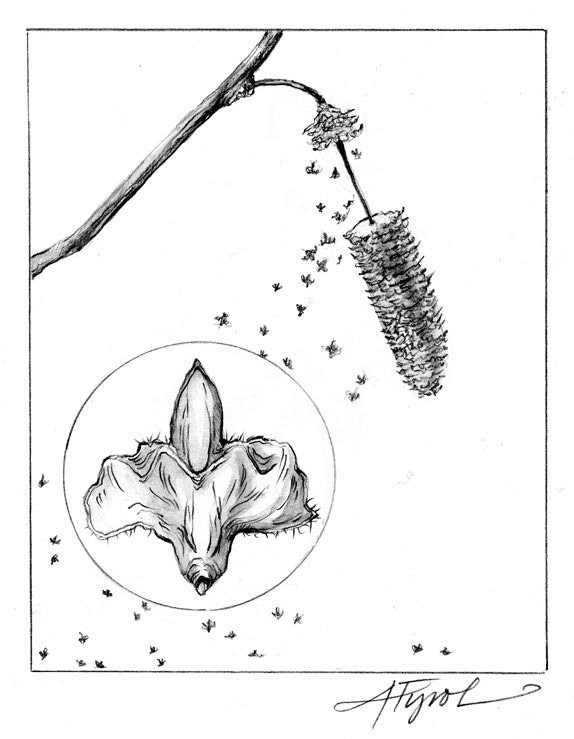
Trees and shrubs can’t pull up roots and traipse around populating the countryside. They spread their seeds with help from wind, water, gravity and animals. Their seeds have parachutes, wings, burrs and other devices that are critical in the moving process.
Many of these seeds make their move on windy days in autumn, but others wait a few months, until deep winter, to take advantage of a special transportation system leading away from home: snow.
We seldom think of snow as an agent of seed transport. Once on the ground, snow appears to be a thick blanket preventing seed movement. Yet, for some plants snow plays a major role in seed dispersal and capture.
One mid-winter day I paused under a large paper birch tree atop a hill near my home in St. Johnsbury, Vt., and was puzzled by a speckling on the crystalline snow around the tree. Bending down, I discovered the spots were hundreds of tiny winged seeds. Paper birch seeds—unlike gray birch seeds that are ready earlier in the season—mature in late autumn. The tree overhead had shed vast quantities of seeds onto the fresh snow. These seeds spread over an area far larger than the diameter covered by the tree’s branches.
As I watched the seeds, a breeze sprang up, and the seeds began shifting on the snow. Suddenly dozens of them lifted off, their minute wings catching the air. They did not become airborne, but skidded and bounded over the hard surface and vanished downhill. While descending the snow-blanketed field, I kept looking for and finding these now widely scattered birch seeds, some hundreds of feet from their tree. It seemed clear that such an extensive dispersal was possible only because of the snow’s icy crust. No such transport would have been possible on mushy snow or during a snowless winter, when seed travel is interrupted by such roadblocks as grass, leaves, logs and rocks. The presence of smooth crusted snow was clearly to the birch tree’s advantage.
Over 100 years ago, Henry Luke Bolley, an agricultural scientist in North Dakota, observed a similar phenomenon. Wanting to know more about winter seed travel, he devised several simple experiments using different kinds of seeds. His chosen plants in one trial ranged from buckwheat and millet to flax and ragweed. He needed little in the way of technique and nothing for apparatus.
With a January breeze blowing 20 m.p.h., Bolley dug a trench in the snow three inches deep, 22 feet long, perpendicular to the wind direction. Standing 165 feet away, he poured a handful of seeds on the snow. After 10 minutes, he counted and identified the seeds caught in the snow trench downwind. He found that some seeds, due to size and shape, moved easily atop snow. Wheat seeds, for example, were 4.5 times more numerous in the trench than buckwheat, and there were far too many trapped millet seeds for him to count. Bolley’s test showed which plants dispersed seeds most effectively across icy snow under breezy conditions.
Bolley’s experiment didn’t end there. He dug ridges into snow along hedgerows and on the leeward side of hills to test his theory that seeds could move long distances “in the driving winds of winter” and then mingle with the snow, and “there await the sun’s releasing energy.” He was right.
In another test, about 30 feet from the nearest standing weeds, Bolley removed one-half cubic foot of snow from a drift and discovered nine kinds of seeds.
His final effort was to investigate whether seeds might be caught and carried within gravity-induced natural snowballs that roll downhill gathering size and momentum as they go. He found that snow rollers not only picked up lots of seeds on the way, but also in some cases they even encapsulated entire seed heads of plants, such as Queen Anne’s lace.
Henry Luke Bolley was a plant pathologist of international distinction with many important discoveries to his name. An observant naturalist with a fertile imagination, his research has enriched my own journeys through snow as I watch seeds move on toward greener pastures.

